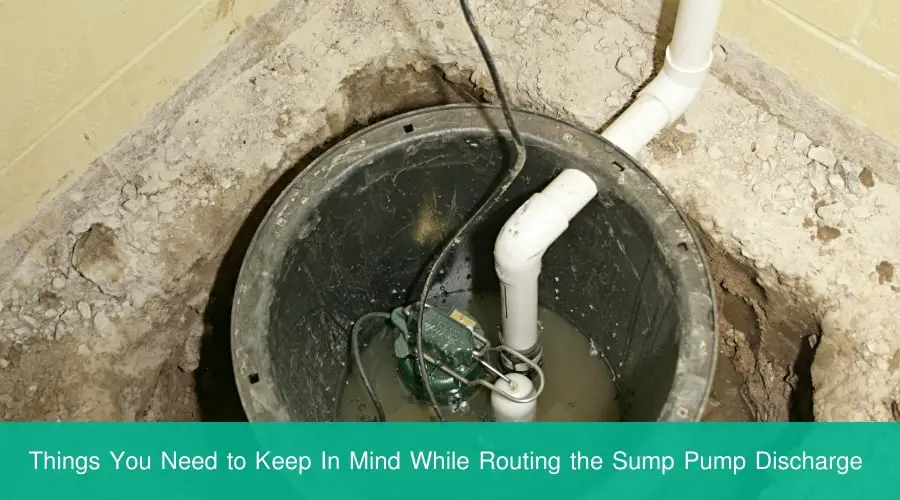Last Updated on August 27, 2022 by admin
One of the main parts of the sump pump is its discharge line. It passes water from the sump pump that is stuck in the basement of your home. Without a discharge line, a sump pump would be nothing but incompetent with no water pumping.
Most people hire a professional installer for installing the route of the sump pump discharge line. Hiring a professional for the task might cost a handsome amount of money. But if you learn how to route sump pump discharge and apply it correctly, it can both save your money and get the job done.
Table Of Contents
- 1 Things You Need to Keep In Mind While Routing the Sump Pump Discharge
- 2 How to Route Sump Pump Discharge Line – The Step-by-Step Process
- 2.1 Step-1: Locate the Sump Pump Basin and the Pipe
- 2.2 Step-2: Connect the Pipes with the Adapters
- 2.3 Step-3: Shape and Tighten the Pipes and Install the Check Valve
- 2.4 Step-4: Check the Frost Line and Dig the Trench
- 2.5 Step-5: Creation of the Slope
- 2.6 Step-6: Connect the Route Pipe and Sump Pump Pipe
- 3 FAQs
- 4 Final Thoughts
Things You Need to Keep In Mind While Routing the Sump Pump Discharge

Just installing the drainage of the sump pump is not everything. There are some factors that play a vast role in the successful installation of the whole sump pump discharge line. If you underestimate those factors, things might go wrong even the discharge route has no-fault.
So, you need to put a close eye on those factors while creating the underground sump pump discharge line, and those factors are:
- Never route the drainage line upwards as water might come back to your house even after discharge.
- Let the gravity flow the water downwards through the discharge route to the central drainage system.
- Keep the water away from both your house and neighborhood and connect it with your area’s drainage line.
- Make sure there is no gas line or other lines beneath the yard from where you are planning to route the sump pump discharge line
- If the sewerage line is not near your house, dig a drainage ditch in your yard and route the sump pump line there.
How to Route Sump Pump Discharge Line – The Step-by-Step Process
Routing the discharge line of the sump pump situated in your basement may look a bit tough in the beginning. But when you have enough knowledge of it with correct instructions, it will start becoming more straightforward. To complete the whole routing task, you need to follow the right path in a step-by-step process.
The steps to follow in this case are:
Step-1: Locate the Sump Pump Basin and the Pipe
The sump pump basin will be near the sump pit in your basement. So, it won’t take much time to locate this part and then find a pipe coming out from the sump pump. Through this, the water from your basement will come out, and you need to connect the whole discharge system with it.
Step-2: Connect the Pipes with the Adapters
From the sump pump, you will see a pipe coming towards the outside with which water will come out. With this pipe, you need to connect a male pipe adapter by applying glue in both the adapter and pipe. Take the discharger, and you will see there is a female pipe adapter coming out from it.
The next thing you need to do is place the previous male pipe adapter into the following female pipe adapter. There should be a significant bit of pipe sticking upwards, and pipes of 1 ¼ or ½ inch diameters will do the job just perfectly.
If you are newly installing the sump pump and routing the discharge line, you should also create a weep hole. Because it will prevent the bursts whenever the pressure water is excessive. This weep hole must be six inches above the pipe, and you can use a drill to create it.
Step-3: Shape and Tighten the Pipes and Install the Check Valve
Then you need to shape the pipes and cut them into the pipe above the weep hole you made a while ago. Use a hacksaw for the task, and after that, install the check valve carefully without any damage. There will be a rubber bearing on the pipe, which you need to tighten and use a screwdriver for the task.
Step-4: Check the Frost Line and Dig the Trench
After all the tasks above, you need to check the depth of the frost line in your locality. It is highly crucial as you need to install the discharge line of your sump pump below that frost line. After that, you will have to dig a trench which should be at least 2-feet wide.
Keep in mind that the trench depth must be three times compared with the frost line.
Step-5: Creation of the Slope
As you have done digging the trench, the next task is creating the slope for the discharge route. So, you will have to create a slope at the beginning of the trench, which you dug just a while ago. While digging the trench, carefully reserve the upper part of the soil with which grasses will be attached.
You need to create a one-inch slope for every eight feet of the string. Make sure the line goes gradually down wise to help the water to flow through the pipe. Lead the trench to where you want to ditch the water, and install a 4-inch pipe throughout the channel.
Step-6: Connect the Route Pipe and Sump Pump Pipe
Create a hole in the wall to bring the sump pump pipe out and connect it with the drainage pipe with an adapter. Install a freeze protection device in there as well for emergency cases. Then, if you are thinking about how to hide sump pump discharge pipe, the grassed soil you kept while digging the trench will be the savior.

FAQs
How deep do I need to dig for routing the sump pump discharge line?
The depth of the sump pump discharge line mainly depends on the frost line of your locality. Suppose, if the frost line is 2 feet, then you need to dig more than that. Keep this in mind while digging the trench for the discharge line, as it is highly crucial and comes under the law.
Will it cause a problem if I discharge the water through the sump pump uphill?
Yes, this might be the cause of a massive problem as sump pumps aren’t capable of sending water uphill continuously. The water you discharged uphill can also come back to your basement if there is any leakage. That’s why you should always route the discharge line down wisely to let the water flow with gravity.
Final Thoughts
The discharge route of the pumped water through the sump pump is highly crucial. It won’t be ideal if you have installed the sump pump properly, but the discharge route is not correct. That’s why you need to acquire as much knowledge as possible about how to route sump pump discharge properly.
Some prefer calling the professionals mainly for the trench digging task. But, if you have a helper and necessary equipment, you can perform and complete tasks yourself.
